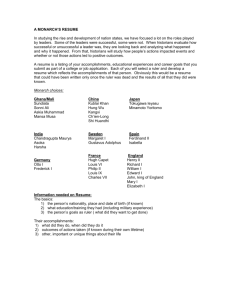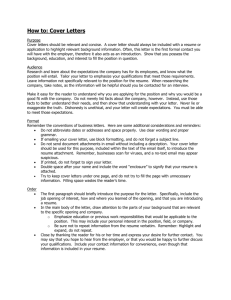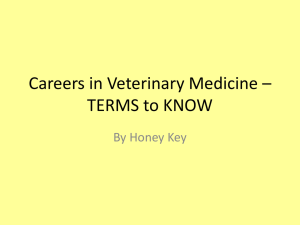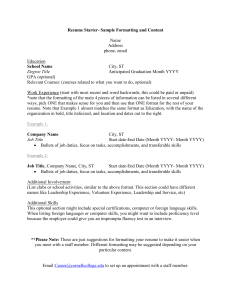Cover Letter Critique Checklist
advertisement
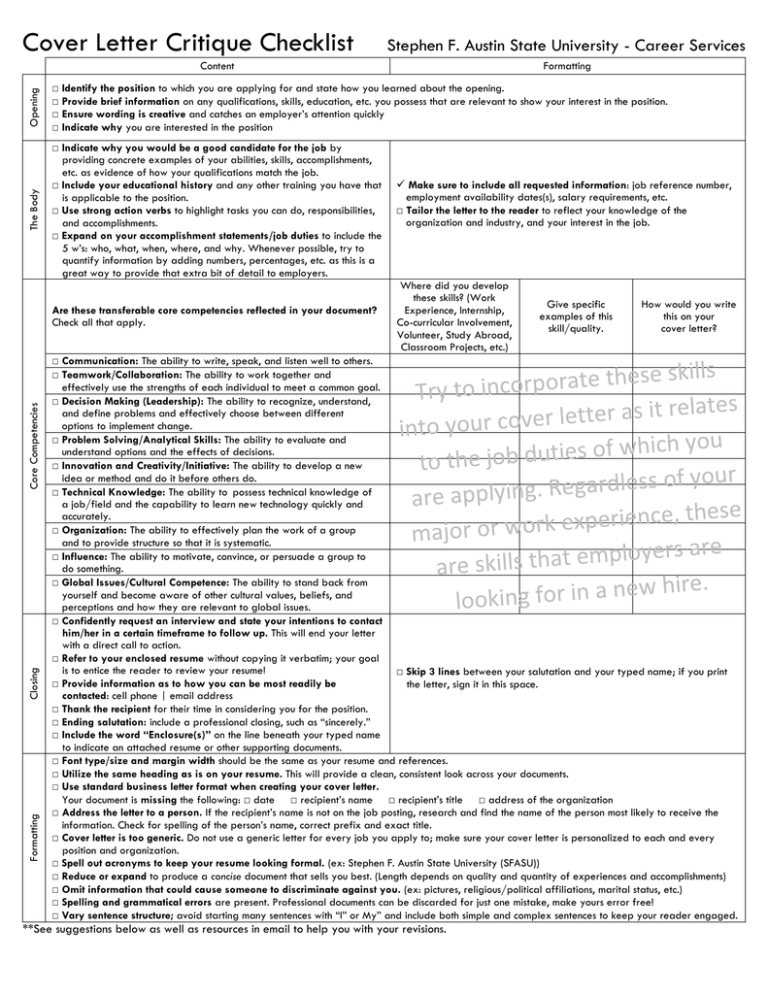
Cover Letter Critique Checklist Stephen F. Austin State University - Career Services Opening Formatting □ Identify the position to which you are applying for and state how you learned about the opening. □ Provide brief information on any qualifications, skills, education, etc. you possess that are relevant to show your interest in the position. □ Ensure wording is creative and catches an employer’s attention quickly □ Indicate why you are interested in the position The Body Content □ Indicate why you would be a good candidate for the job by providing concrete examples of your abilities, skills, accomplishments, etc. as evidence of how your qualifications match the job. □ Include your educational history and any other training you have that is applicable to the position. □ Use strong action verbs to highlight tasks you can do, responsibilities, and accomplishments. □ Expand on your accomplishment statements/job duties to include the 5 w’s: who, what, when, where, and why. Whenever possible, try to quantify information by adding numbers, percentages, etc. as this is a great way to provide that extra bit of detail to employers. Formatting Closing Core Competencies Are these transferable core competencies reflected in your document? Check all that apply. Make sure to include all requested information: job reference number, employment availability dates(s), salary requirements, etc. □ Tailor the letter to the reader to reflect your knowledge of the organization and industry, and your interest in the job. Where did you develop these skills? (Work Experience, Internship, Co-curricular Involvement, Volunteer, Study Abroad, Classroom Projects, etc.) Give specific examples of this skill/quality. How would you write this on your cover letter? □ Communication: The ability to write, speak, and listen well to others. □ Teamwork/Collaboration: The ability to work together and effectively use the strengths of each individual to meet a common goal. □ Decision Making (Leadership): The ability to recognize, understand, and define problems and effectively choose between different options to implement change. □ Problem Solving/Analytical Skills: The ability to evaluate and understand options and the effects of decisions. □ Innovation and Creativity/Initiative: The ability to develop a new idea or method and do it before others do. □ Technical Knowledge: The ability to possess technical knowledge of a job/field and the capability to learn new technology quickly and accurately. □ Organization: The ability to effectively plan the work of a group and to provide structure so that it is systematic. □ Influence: The ability to motivate, convince, or persuade a group to do something. □ Global Issues/Cultural Competence: The ability to stand back from yourself and become aware of other cultural values, beliefs, and perceptions and how they are relevant to global issues. □ Confidently request an interview and state your intentions to contact him/her in a certain timeframe to follow up. This will end your letter with a direct call to action. □ Refer to your enclosed resume without copying it verbatim; your goal is to entice the reader to review your resume! □ Skip 3 lines between your salutation and your typed name; if you print □ Provide information as to how you can be most readily be the letter, sign it in this space. contacted: cell phone | email address □ Thank the recipient for their time in considering you for the position. □ Ending salutation: include a professional closing, such as “sincerely.” □ Include the word “Enclosure(s)” on the line beneath your typed name to indicate an attached resume or other supporting documents. □ Font type/size and margin width should be the same as your resume and references. □ Utilize the same heading as is on your resume. This will provide a clean, consistent look across your documents. □ Use standard business letter format when creating your cover letter. Your document is missing the following: □ date □ recipient’s name □ recipient’s title □ address of the organization □ Address the letter to a person. If the recipient’s name is not on the job posting, research and find the name of the person most likely to receive the information. Check for spelling of the person’s name, correct prefix and exact title. □ Cover letter is too generic. Do not use a generic letter for every job you apply to; make sure your cover letter is personalized to each and every position and organization. □ Spell out acronyms to keep your resume looking formal. (ex: Stephen F. Austin State University (SFASU)) □ Reduce or expand to produce a concise document that sells you best. (Length depends on quality and quantity of experiences and accomplishments) □ Omit information that could cause someone to discriminate against you. (ex: pictures, religious/political affiliations, marital status, etc.) □ Spelling and grammatical errors are present. Professional documents can be discarded for just one mistake, make yours error free! □ Vary sentence structure; avoid starting many sentences with “I” or My” and include both simple and complex sentences to keep your reader engaged. **See suggestions below as well as resources in email to help you with your revisions.
